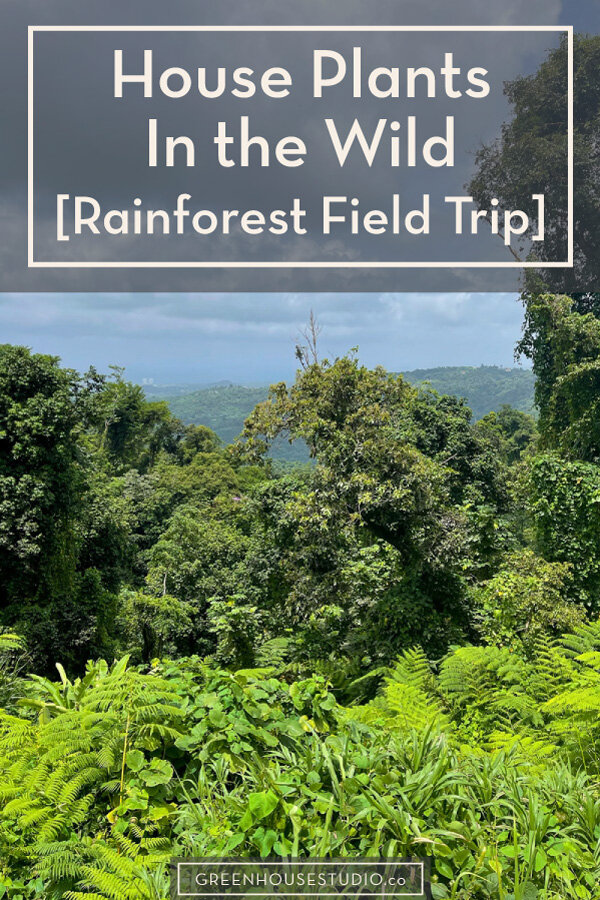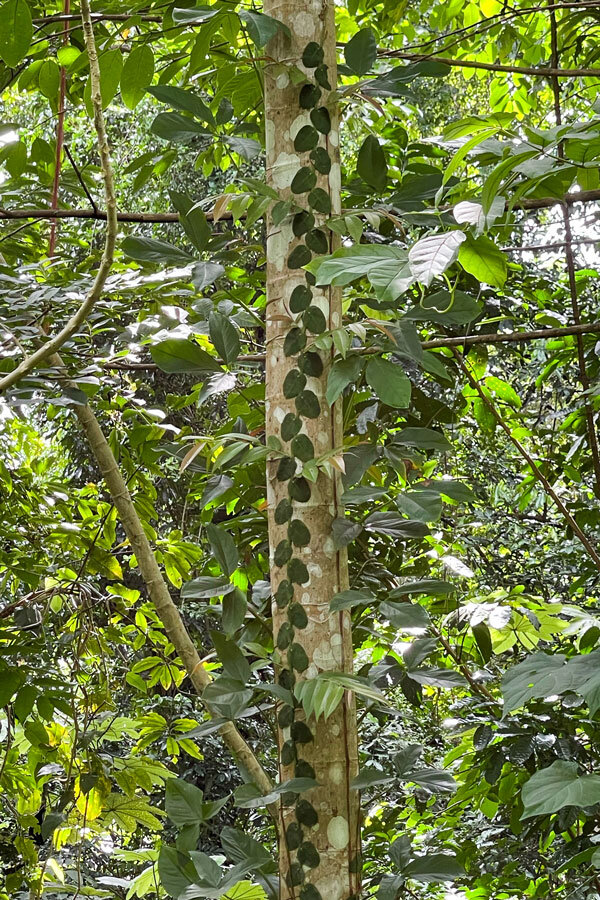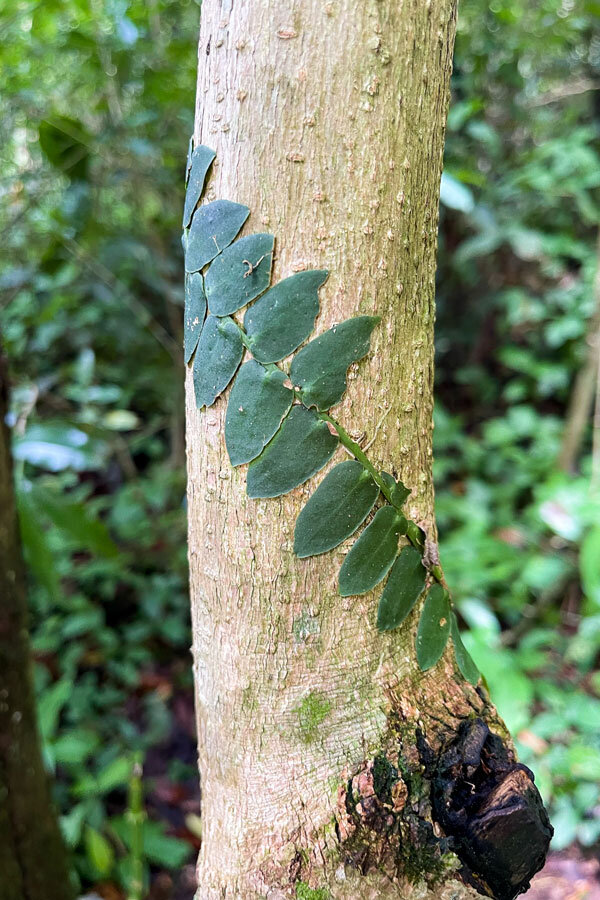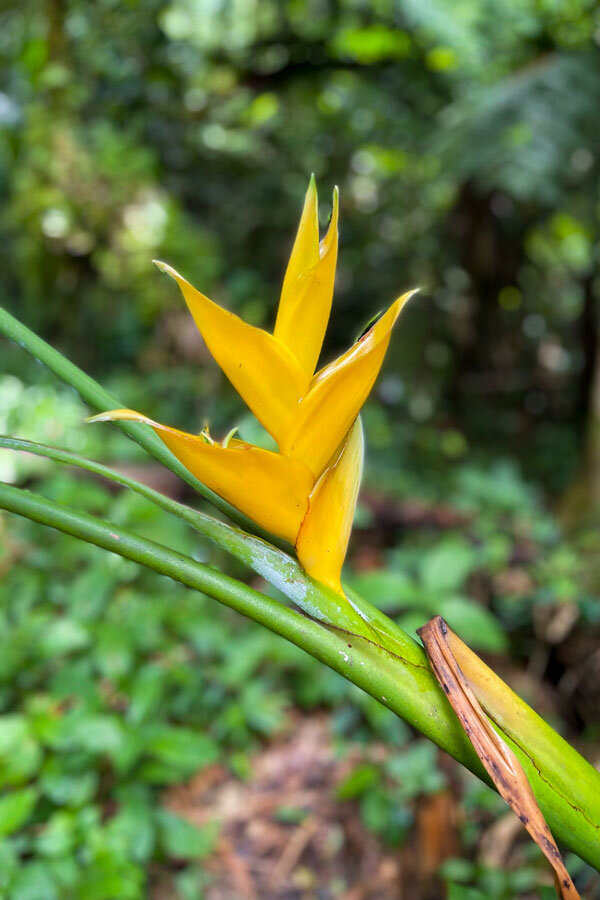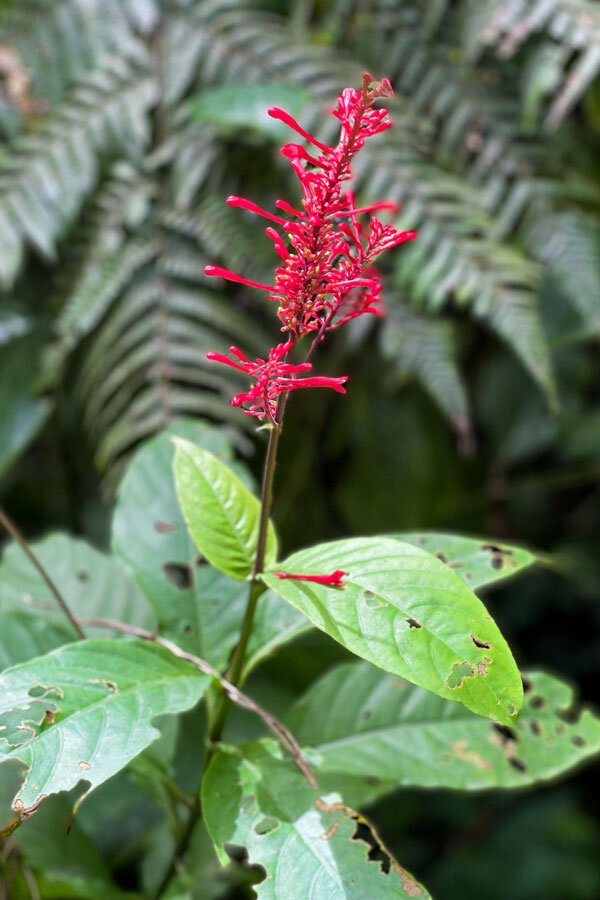El Yunque National Forest [Puerto Rico Tropical Field Trip]
Do any of you get as excited as I do about seeing some of our favorite indoor tropical plants growing and thriving outdoors?
Besides just the novelty of seeing a plant many of us think of as a “houseplant” growing outside, it’s also interesting to observe how their growth habits differ in a natural environment.
Backstory - I took my boys on a vacation to Puerto Rico. We were thrilled to learn it’s home to El Yunque National Forest, the only rainforest in the US National Forest Service.
In the capital city of San Juan as well, there were many “indoor plants” we saw growing as stunning landscape plants. (Including our favorite FLFs!)
It was spectacular, and I want to share with you some of the botanical wonders we saw there.
[This post contains affiliate links. Click here to read my full disclosure.]
El Yunque is a cool, mountainous, tropical rainforest on the north east coast of Puerto Rico by the Sierra de Luquillo mountains. It has a year-round tropical climate and incredible biodiversity.
The city of San Juan is just a 45 minute drive north. Both climates are tropical year round which means they don’t freeze, allowing for a year-round growing season.
Looking up towards the Sierra Del Luquillo mountains from the El Yunque Rainforest.
Hiking down El Yunque’s Angelitos trail - no machetes required, although my boys would have loved that.
The dense foliage is almost leaning into the river. Lots of locals and tourists alike were swimming here at the end of the Angelitos trail.
House Plants In The Wild
Vines & Climbers
It’s a lot of fun to see how ingeniously so many vine and climber type plants have evolved to make their way towards the light. Where there’s a will there’s a way no matter what kind of surface they have to work with!
All kinds of vines growing up a historic Old San Juan wall including ficus, ferns, and philodendron.
This is what I meant in the intro about seeing how differently plants grow in the wild. Below is a Golden Pothos (Epiprenum aureum). Look at how huge the leaves are. Many even have split margins. So different from the reserved house plant we thought we knew.
Use my big, humidified hair for scale for the huge Golden Pothos leaves (Epiprenum aureum) growing up an enormous ficus tree at Casa Blanca museum & gardens in Old San Juan.
OK I know many of your will share my excitement at spotting a shingling type creeper in the wild!
A shingling plant is a creeping vine in Aroid family, Araceae. Araceae includes many popular houseplants from Anthurium to Monstera to Philodendron.
Shingle vines get their name from the “shingling” behavior exhibited by the foliage which grows flat against it’s growing surface - usually a tree.
Most shingle plants fall into the genus Rhaphidophora. There’s surprisingly little academic information about Rhaphidophora though. I know not all Rhaphidophora are shingling plants, but I don’t know if there are any plants with a shingle growth habit outside the genus.
So I can’t say if these two are Rhaphidophora or not, but just look at how flat they’re pressed against the tree trunks - so cool! (And if anyone does know, leave a comment below.)
Update: Ask and ye shall receive :) Local plant expert Rey X Perez left a comment telling me this is in fact, Marcgravia sintenisii, a shingling vine native to Puerto Rico!
This shingle vine, Marcgravia sintenisii, growing in El Yunque National Forest is native to Puerto Rico. Look at all of the progress it has made growing up that tree trunk towards the sun!
Marcgravia sintenisii shingle vine and Puerto Rico native plant growing in El Yunque. Shingle vines grow flat against their growing surfaces.
Here’s a garden variety Philodendron snaking it’s way up a tree trunk. Look at the aerial roots it has produced to cling to the tree.
Philodendron aerial roots grow above the soil and serve two primary purposes. They stabilize the plant when it’s climbing, and they allow it to collect extra water and nutrients.
Honestly, I saw the same philodendrons for sale at Trader Joes yesterday!
A Philodendron growing up on a tree trunk. It’s “grabbing” the tree trunk with it’s aerial roots. When plants respond to a surface or stimuli it’s called Thigmotropism
The same type of Philodendron growing vertically on an El Yunque tree branch.
Epiphytes
Epiphytes are plants that grow on another surface like a tree trunk, branch or rock rather than in soil. Lots of popular house plants are epiphytes including air plants, their cousins the bromeliads, staghorn ferns, most orchids, and some other ferns.
I was excited to find this large bromeliad perched on a branch below. It looked very healthy!
A large bromeliad growing on a branch in El Yunque rainforest.
Some house plants like bird’s nest ferns (Asplenium spp.) are sold in soil for the nursery trade but usually grow as epiphytes in the wild. I spotted lots of bird’s nest ferns growing on various tree trunks and branches.
This branch was covered with bird’s nest ferns (and lots of other little creepers if you look closely)!
Here’s another asplenium / bird’s nest fern perched alone on a branch.
Terrestrial Tropicals
Back down on the ground, there were lots of these big elephant ear types growing in large clumps - either Alocasia or Xanthosoma below. They seemed to prefer slightly sunnier, more open spots over growing in the shadier understory.
Elephant Ear Alocasias growing in large clumps - they spread via tubers.
This cute bi-colored alocasia was popping up from the forest floor shrubbery.
And I was quite surprised to see my favorite Burgundy Rubber Tree, Ficus elastica ‘Burgundy’, planted en masse in a large landscape bed at our hotel.
This picture is making me feel guilty - I’ve needed to transplant my poor burgundy rubber plant for a year now!
Burgundy Rubber Tree, Ficus elastica ‘Burgundy’ used in a landscape planting bed. If you look closely, you can see most of them have been pruned.
Tropical Flowers
What’s more spectacular and showy than tropical flowers? Mother Nature is truly amazing.
Below are two types of Heliconias. Heliconias are closely related to birds of paradise (Strelitzia) and bananas (Musa) - in fact they used to be under the same family name until broken out into 3 separate families around 20 years ago.
The amazing red and yellow one below is called a lobster claw for obvious reasons - incredible!
A lobster claw heliconia growing in the Casa Blanca house gardens in Old San Juan. Lobster claw flowers always hang downwards.
Below is an upright type of heliconia flower. They look so similar to birds of paradise that I’ve always wondered why they are placed in heliconia rather than strelitzia, but hey, I’m not a plant taxonomist.
This beautiful upright-type yellow heliconia was growing in the El Yunque forest. You can see how similar it looks to it’s close cousin, a bird of paradise flower.
This deep pink flower was growing in the rainforest. After some research, I’m 99% sure it’s in the Odontonema genus - a Firespike Plant native to Central America. If anyone can definitively I.D. it, leave a comment below.
Odontonema or Firespike Plant native to Central America. Note how the leaves grow opposite each other rather than alternate. Opposite leaves are much less common.
Tropical Trees
Trees, just like bugs, grow huge in the tropics, and there were some impressive specimens in Puerto Rico, both in the forest and the landscape.
The Yagrumo tree (Cecropia peltata) below has giant palmate (lobed) shaped leaves, and the undersides are actually a startling white-silver color when the sun hits them.
Our El Yunque ziplining guide shared that people who live near the forest know to watch for them when a storm’s approaching. If they look off in the distance and see a lot of silver, they know the wind is blowing hard exposing the silver underside so it’s time to take cover.
Yagrumo Hembra or Trumpet Trees (Cecropia peltata) growing in El Yunque.
Yagrumo Hembra or Trumpet Tree (Cecropia peltata) leaf. Seeing the silver colored undersides warns locals from a distance that wind is kicking up and a storm is coming.
We were lucky - the Flamboyan or Royal Poinciana trees (Delonix regia) were in full bloom with their spectacular flame red flowers. These trees are huge and were blooming everywhere, from our hotel below to alongside the freeway and beyond. Royal Poincianas are truly an iconic tree in Puerto Rico.
Originally from India, they thrive in dry climates and are most flamboyant on the drier south coast but still grow beautifully in the wetter north and forested areas. They bloom from spring through summer.
Flamboyan or Royal Poinciana tree, Delonix regia. El San Juan Hotel.
Just as impressive were some of the giant ficus trees, especially the one below at our hotel. It’s enormous, and the hotel built a patio around it.
This spectacular grand-daddy ficus tree dwarfs the palms below it. El San Juan Hotel.
This big ficus tree looks petite compared to the one above, but look at it’s impressive aerial roots. Costa Blanca house, Old San Juan.
Speaking of ficus, I know many of you came to Greenhouse Studio originally for the Fiddle Leaf Fig info. Lemme tell ya - the FLFs were planted everywhere and they were huge!
They seemed to be a landscape tree of choice - from the Walmart parking lot to street tree alleés in Old San Juan.
Fiddle Leaf Fig (Ficus lyrata) growing at the Institute of Neurobiology in Old San Juan.
One of several fiddle leaf figs planted around the Luquillo Walmart farmacia parking lot.
Below is a fiddle leaf look alike and a new tree to me! I thought this was a different variety of fiddle leaf but Puerto Rican local and plant expert Rey X Perez told me this is in fact a Terminalia catappa, aka the Beach Almond tree.
If you ever find yourself in a situation where you’re wondering “Is this tree a FLF or Beach Almond?” (hey, it could happen) - one way to check would be to pull off one of the leaves and look for the tell-tale milky sap since the fig family (Moraceae) is one of only about 5 plant families that have milky sap.
This big Beach Almond tree (Terminalia catappa) lived up to it’s name - perfectly happy growing on the beach at the El San Juan hotel.
The same Beach Almond tree was full of non-showy, white flowers. See the “almond” in the middle? It floats, and they’ve evolved to disperse their seeds via water. (Like coconut palms.)
Finally, check out the beautiful courtyard garden below. You can see why so many homes are painted in bright colors in tropical locales - they look perfectly natural next to all the bright flowers and foliage surrounding them.
A courtyard garden in Old San Juan with bougainvillea, alocasia, heliconia, sage, aloes, and yucca.
Well that’s the botanical side of our family vacay. I hope you had fun seeing some of our favorite tropicals growing in Puerto Rico’s urban landscape and rainforest. I think it’s helpful to see how things grow in their natural environment since it gives us a better idea of their full potential.
Have you seen any “indoor” plants growing outdoors or even in a greenhouse? What surprised you most about seeing them in that kind of environment? - Leave a comment below.
Enjoy the post? Pin it for later!
If you have any questions or comments, please drop me a note below. Be sure to check back for my response (I always respond) since no notification is sent.
XO,
Tina

